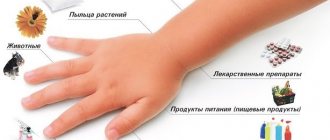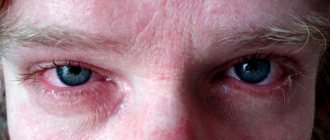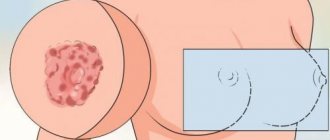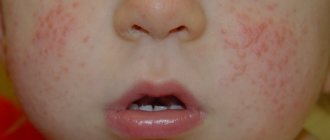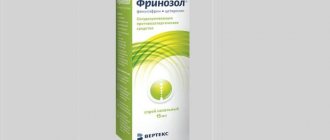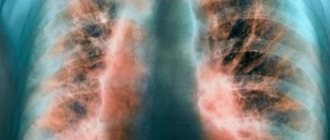Home › Child under one year old › Diseases
Author of the article
Ekaterina Rakitina Doctor Dietrich Bonhoeffer Klinikum, Germany
Reading time: 4 minutes
AA
Article last updated: 05/10/2019
Allergic rhinitis in an infant, the symptoms of which are very difficult to miss, since this disease has a fairly definite picture. At the first manifestations of rhinitis in a baby, father and mother need to contact a competent specialist to accurately determine the type of disease, its causes and choose the right treatment.
Mechanics of the disease
The moment the body recognizes the allergen as something dangerous, an allergic reaction begins. Often this is simple inflammation. Almost anything can become an allergen. A child's body is still too weak when compared with the immune system of an adult. Any food product and other things can become an allergen, but first things first.
And in every allergic reaction certain antibodies will be involved. Immunoglobulin E (IgE) is the main participant in these “battles”. An allergen that has entered the body causes it to produce a large amount of the antibodies described above. These elements are eventually added to mast cells. Antibodies turn into sediment and are found in the eye, nose, lungs or mucous membranes of the patient.
Symptoms of allergic rhinitis in a child are often accompanied by constant sneezing, wheezing, coughing and runny nose. The disease is often confused with a cold, but there is one difference. Allergic rhinitis plagues a child for more than 4 full weeks a year, which is difficult to attribute to milder diseases.
Important! It is mast cells that cause all the above symptoms. In other words, these elements represent the “remnants” of the immune system’s fight against allergens.
Also among the participants in the appearance can be called histamine, which is produced by mast cells. The IgE antibodies that we talked about above can be of different groups. They directly depend on the allergen. Someone may suffer from cat hair, while another calmly tolerates it, but cannot help but sneeze next to a flower. These are individual characteristics of the body; you never know what you may be allergic to.
Signs of allergic rhinitis
Year-round allergic rhinitis is characterized by constant nasal congestion and difficulty breathing, especially if the room is smoky or very dry.
Seasonal allergic rhinitis has more striking symptoms:
- Excessive snotty;
- Unbearable nasal itching;
- Repeated sneezing;
- Burning in the eyes and dark circles around them;
- Headache.
In some cases, the child's temperature rises slightly and a dry cough appears. Coughing indicates the development of concomitant allergic pharyngitis, laryngitis. There may be swelling and redness of the eyelids and skin above the upper lip and at the sides of the nose, as well as bleeding due to attempts to clear the nose.
Reason for development
Symptoms of allergic rhinitis in children are always caused by one of the main types of allergen. This may be an inhalation option, a microbial allergen or a food product. The first type can be divided into the following groups:
- Homemade.
- Vegetable.
- Animal.
- Fungal.
All of these types can live in your home. Sometimes a dietary or microbial allergen can intervene and cause rhinitis symptoms, but this is very rare. A child can get sick right in his home if you have animals, plants, and so on. House dust is one of the most common allergens that cause rhinitis in children. Animals produce not only fur, but also dandruff.
Important! You should also be wary of pet excrement, especially birds.
.
Fungal spores are a microscopic type of fungus; they live not only in comfortable home conditions, but also in ventilation, damp and dark rooms. Most often, distributors are various industries that are related to pharmaceuticals, leather, food or textiles. An allergic runny nose in a child can be caused by contact with food that was in a room with fungus. A few microscopic spores are enough.
Microbial allergens cannot activate inflammatory processes due to the fact that they are quickly destroyed by the immune system. But there is an exception - respiratory infections or ear diseases. If a child suffers from such diseases, germs can enter the body while the immune system is distracted by other problems. Allergic rhinitis can also be caused by:
- Bad ecology.
- Lack of vitamins in the body.
- Dry climate, lack of fresh air.
- Unfavorable conditions in which the child is: dirt, minimum hygiene, and so on.
About the problem
one of the many viruses that always surround a child gets onto the nasal mucosa. In response, the immune system gives the command to secrete as much mucus as possible, which should isolate the virus from other organs and systems, preventing it from moving further through the nasopharynx, larynx, bronchi and lungs.
In addition to the viral form, which accounts for about 90% of all cases of children's runny nose, according to Evgeniy Komarovsky, rhinitis can be bacterial. This causes pathogenic bacteria to enter the nasal cavity. The body reacts in a similar way - with increased mucus production. Bacterial rhinitis itself is extremely rare, and its course is always very severe. Bacteria (most often staphylococci) cause severe inflammation, suppuration, and toxic waste products cause general intoxication.
Usually these bacteria are harmless; they live in the nose and mouth on a permanent basis and do not bother the child in any way. However, in conditions of an abundance of mucus, its stagnation, drying out, microbes become pathogenic and begin to multiply rapidly. This usually happens with complicated rhinitis.
The third, fairly common cause of runny nose in children is allergies. Allergic rhinitis occurs as a reaction of local immunity to a protein antigen. If such a substance enters the body, the nasal mucosa reacts with swelling, making it difficult for the child to breathe through the nose.
In some cases, nasal congestion and impaired nasal breathing are associated with ENT diseases, such as adenoids. If the runny nose is acute (occurred no earlier than 5 days ago), then there should be no reason for special concern. In case of persistent snot and other symptoms, it is better to consult an otolaryngologist.
Main symptoms
Allergic rhinitis in children can cause a range of different symptoms. The baby may complain that he has:
- Stuffy nose.
- Watery nasal discharge, often profuse.
- Sneezing attacks.
- Itching in the nose, and this sensation easily spreads to the entire oral cavity and ears.
- The face swells.
- Sore throat, constant cough.
- The eyes water, they may hurt, as if they are under constant tension.
Important! The main symptom of allergic rhinitis in a child is periodic sneezing several times in a row, which follows each other, virtually without stopping.
An allergen can cause not one-time or long-term symptoms, but also permanent ones. In this case, you may experience:
- Nasal congestion throughout the year may change, but will always be present.
- Nosebleeds are a common occurrence with persistent symptoms.
- Sinusitis and otitis media can develop along with allergic rhinitis.
- Nasal voice is one of the symptoms.
- A child, even a small one, may begin to snore in his sleep.
Important! In a constant, intense form, rhinitis can directly affect the child’s daily life: his success in school, personal life, sleep and level of attentiveness also deteriorate.
Runny nose in infants
Parents often ask how to treat a runny nose in newborns and infants. Evgeniy Komarovsky argues that such babies do not always require treatment as such. If it seems to the mother that the baby is snoring or wheezing in his sleep, this is not always rhinitis. In infants, the nasal passages are very narrow, which makes nasal breathing somewhat difficult.
If the nose does not breathe, breathes poorly, or mucous discharge appears, it should be remembered that it is the narrowness of the nasal passages in infants that makes it difficult for mucus to flow out, and therefore the risk of developing a bacterial infection is significantly higher in them than in older children. The baby doesn't know how to blow his nose yet. Parents will need to buy an aspirator and help the little one clear the nasal passages of accumulated snot. You can drip salt solutions, give them water and moisturize them too.
If a baby has white snot coming out of his nose, it is mucus mixed with milk or formula. This happens if the child burps unsuccessfully (partially into the nose). There is no need to treat anything in this situation either. Remove white mucus and rinse the nose with saline solution.
Nasal congestion sometimes occurs during teething. In this situation, parents are also required to do the minimum necessary to create normal conditions. There is no point in dripping and treating such a runny nose; as soon as the teeth erupt, the swelling in the area of the nasal passages will subside on its own.
How to diagnose the disease
Symptoms can vary greatly not only depending on the allergen, but also on the child’s body. If the immune system is weak, complications may occur. A hardened organism is able to constantly resist. Treatment of allergic rhinitis in children is a complex process; diagnosis in this case is simply necessary. Often carried out:
- A complete survey of parents for the presence of similar diseases throughout life; a genetic predisposition is possible.
- Blood tests also take nasal swabs to look for eosinophils.
- Doctors may prescribe various skin tests for allergens.
- Rhinoscopy, during which a specialist examines the nasal cavity using small mirrors.
- Ultrasound, CT and x-rays to examine the sinuses.
- Analysis of the amount of immunoglobulin E in the patient’s blood.
Important! All studies can be divided into: physical and visual. Doctors advise carrying out specific tests and only if they do not give an unambiguous answer, proceed to an external examination of the patient.
Treatment
Symptoms and treatment of allergic rhinitis in a child are always divided into several groups. The first option may be non-drug, the second - using medications. Many parents are interested in the first method because of its safety for the body. The basis of this method is to eliminate the allergen from the child’s daily life.
- If your child has a runny nose due to pollen, you need to constantly ventilate the room. But she can also be outside the room. In this case, it is worth reducing the number and time of walks and after each such session thoroughly wash the baby in the shower. This will help remove pollen, and therefore the allergen. Doctors advise thinking about installing an air conditioner. Otherwise, during flowering, you can take the child to grandma or to the sea. Remove all products that are similar in composition to the allergen.
- If your child has a runny nose due to mold spores. It is worth ventilating the room once an hour, and preferably the entire apartment. You should also get into the habit of cleaning your home every day. A humidifier or air conditioner will help get rid of excess spores in the air.
- If your child has a runny nose due to dust. Again, constant wet cleaning of the house will solve the problem. Also wash your bedding more than once a week. No carpets or upholstered furniture in the apartment! It is advisable to replace these items with those made of leather, suede, and so on.
- If your child has a runny nose because of a pet. Often there is only one chance to get rid of allergic rhinitis - to give your pet to friends or in good hands. If the child resists and makes such a step impossible, it is necessary to minimize contact with the animal. Wet cleaning and constant ventilation will reduce the number of allergens.
- If your child has a runny nose due to allergenic food. In this case, you should remove all allergenic products. They are divided into three groups: high level of danger, medium and low. You can easily find all these lists on the Internet. The first two groups should be excluded completely. You can also conduct high-quality diagnostics and tests in the hospital, which will allow you to understand which product is causing the symptoms of rhinitis. In this case, you won’t have to deprive your child of most of the goodies.
Important! If you remove the allergen from the child’s diet and slowly introduce food back, the body may “outgrow” it. In small doses, once hostile elements begin to be perceived by the immune system as familiar.
Medicines
Allergic rhinitis and its treatment in a child may be accompanied by medications. This is a more effective method, but often parents want to abandon it due to the small age of the baby. Sometimes medications are the only way to get rid of allergic rhinitis. The following drugs are used:
- Antihistamine group. This includes Zyrtec, Erius, Allergodil. Medicines in this group can completely relieve all the symptoms of allergic rhinitis, especially nasal congestion, runny nose and sneezing with itching.
- Local hormonal group. An excellent choice would be Budesonide, Mometasone. Almost instantly eliminates stuffy nose, scabies, sneezing and any symptoms of a runny nose. Often this group is prescribed by a doctor for several weeks or months; they can “work” only in the nasal cavity; other symptoms, if any, remain.
- Moisturizing group. Aquamaris, Salin. Cleans the nasal passage and moisturizes it.
- Cromon group. Lomuzol, Cromolyn, Cromosol - all these drugs will be an excellent prevention of allergic rhinitis. But they do not last long, so they cannot become the medicine that will relieve the main symptoms.
- Vasoconstrictor group. Otrivin, Nazol. The main site of drug exposure is the nasal cavity. Reduce swelling and nasal congestion. The downside is that it becomes quickly addictive; as a result, the drug simply stops working or causes side effects. These include bleeding, dry nose, and itching.
Important! Treatment of allergic rhinitis in school-age children should not end with medications alone. It is necessary to develop special immunotherapy. Over the course of three to five years, allergens will be introduced into the body, the dose increasing over time. The principle acts like cold water quenching.
Immunotherapy as a rare type of medicine
European doctors have long developed a specific therapy that allows you to completely get rid of allergies over a long period. The idea is to introduce a small amount of the allergen into the child's body for a long time. Initially, you need to diagnose and identify the type of allergy. Next, a special allergen is selected and administered in small doses.
Is it worth using folk remedies?
Folk remedies are not an effective method of combating allergic rhinitis. Moreover, they can be dangerous. Since most of these methods are based on a large number of herbal tinctures and so on, the child can only get worse. Especially if his allergies are due to pollen or food.
Important! Experts strongly recommend not to risk the baby’s health and use standard treatment methods.
Possible complications
Allergic rhinitis causes more than just typical symptoms. It affects the child's entire life. Complications can be not only physical, but also psychological.
Decreased motor skills and academic performance
Nasal allergies make a child constantly tired. This directly affects performance in school or kindergarten. Sleep disturbance and fatigue even if the child did not take part in active games. The main reason for this behavior is called nasal congestion.
Asthma and eczema may occur
Allergies are often linked to asthma and work together. Especially if the allergy is of the nasal type, which includes rhinitis. If the disease is ignored, and it has been tormenting the child for a long time, additional diseases may develop. Asthma and eczema are at risk for this type of allergy. If rhinitis is chronic, then it can not only cause the appearance of other diseases, but also worsen their symptoms.

